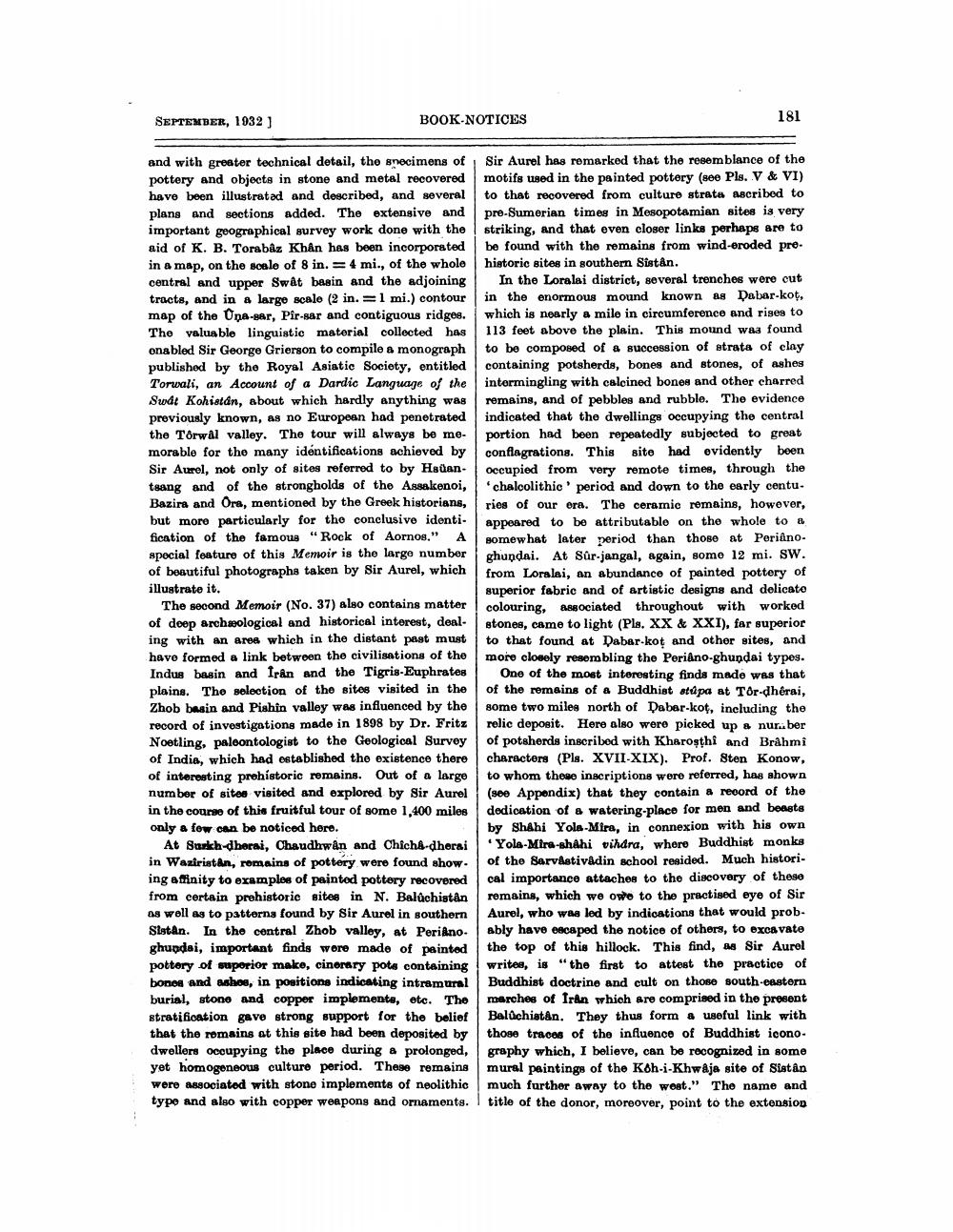________________
SEPTEMBER, 1932 ]
BOOK-NOTICES
181
and with greater technical detail, the snecimens of Sir Aurel has remarked that the resemblance of the pottery and objects in stone and metal recovered motifs used in the painted pottery (see Pls. V & VI) have been illustratad and described, and several to that recovered from culture strata ascribed to plans and sections added. The extensive and pre-Sumerian times in Mesopotamian sites is very important geographical survey work done with the striking, and that even closer links perhaps are to aid of K. B. Torabaz Khan has been incorporated be found with the remains from wind-eroded prein a map, on the scale of 8 in. = 4 mi., of the whole historic sites in southern Sistán. central and upper Swat basin and the adjoining In the Loralai district, several trenches were cut tracts, and in a large scalo (2 in. El mi.) contour in the enormous mound known as Dabar-kot. map of the Una-Bar, Pir-sar and contiguous ridges which is nearly a milo in circumference and rises to The valuable linguistic material collected has 113 feet above the plain. This mound was found onabled Sir George Grierson to compile a monograph to be composed of a succession of strata of clay published by the Royal Asiatic Society, entitled containing potsherds, bones and stones, of ashes Torwali, an Account of a Dardic Language of the intormingling with calcined bones and other charred Sude Kohistán, about which hardly anything was remains, and of pebbles and rubble. The evidence previously known, as no European had penetrated indicated that the dwellings Occupying the central the Torwal valley. The tour will always be me portion had been repeatedly subjected to great morable for the many idóntifications achieved by conflagrations. This site had ovidently been Sir Aurel, not only of sites referred to by Hsuan- occupied from very remote times, through the tsang and of the strongholds of the Assakenoi, |'chalcolithic period and down to the early centu. Bazira and Ora, mentioned by the Greek historians, ries of our ora. The ceramie romains, however, but more particularly for the conclusive identi
appeared to be attributable on the whole to & fication of the famous "Rock of Aornos." A
somewhat later period than those at Periânospocial feature of this Memoir is the large number
ghundai. At Sür.jangal, again, somo 12 mi. SW. of beautiful photographs taken by Sir Aurel, which from Loralei, an abundance of painted pottery of illustrate it.
superior fabric and of artistic designs and delicate The second Memoir (No. 37) also contains matter
colouring, associated throughout with worked of doop archaeological and historical interest, deal. stones, came to light (Pls. XX & XXI), far superior ing with an area which in the distant past must to that found at Dabar.lot and other gites and have formed a link between the civilisations of the
more closely resembling the Peridno-ghundai typos. Indus basin and Iran and the Tigris-Euphrates
One of the most interesting finds made was that plains. The selection of the site visited in the of the remains of a Buddhist atdpa at Tor-dhérai, Zhob basin and Pishin valley was influenced by the some two miles north of Dabar-kot, including the record of investigations made in 1898 by Dr. Fritz relic deposit. Here also were picked up & nur..ber Noetling, paleontologist to the Geological Survey of potsherds inscribed with Kharoşthi and Brahmi of India, which had established the existence there characters (Pls. XVII-XIX). Prof. Sten Konow, of interesting prohístoric remains. Out of a large to whom these inscriptions were referred, has shown number of sites visited and explored by Sir Aurel (see Appendix) that they contain & record of the in the course of this fruitful tour of some 1,400 miles dedication of watering-place for men and beasts only a few can be noticed here.
by ShAhi Yola-Mira, in connexion with his own At Sukh-dherai, Chaudhwan and Chicha-dherai Yola-Mira-shAhi vihdra, where Buddhist monks in Waziristan, remains of pottery were found show. of the Sarvletivadin school resided. Much historiing affinity to examples of paintod pottery recovered cal importance attaches to the discovery of these from certain prehistoric sites in N. Baluchistan romains, which we owo to the practised eye of Sir as well as to patterns found by Sir Aurel in southern Aurel, who was led by indications that would prob. Sistan. In the central Zhob valloy, at Periano ably have escaped the notice of others, to excavate ghupdai, important finds wore made of painted the top of this hillock. This find, as Sir Aurel pottery of superior make, cinorary pots containing writes, is "the first to attest the practice of bones and ashes, in positions indicating intramural Buddhist doctrine and cult on those south-eastern burial, stone and copper implemente, etc. The marches of Iran which are comprised in the present stratification gave strong support for the belief Baluchistån. They thus form a useful link with that the remains at this site had been deposited by those traces of the influence of Buddhist icono. dwellers occupying the place during a prolonged, graphy which, I believe, can be recognized in some yet homogeneous culture period. These remains mural paintings of the Koh-i-Khwaja site of Siatan were associated with stone implements of neolithic much further away to the west." The name and type and also with copper weapons and ornaments. I title of the donor, moreover, point to the extension




